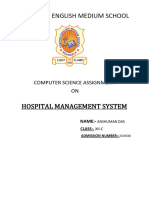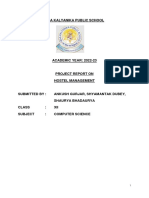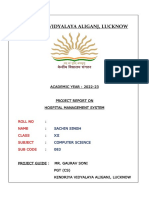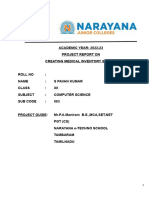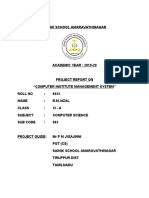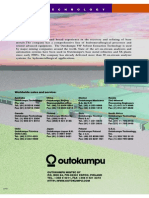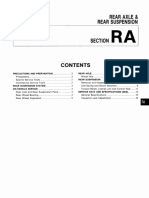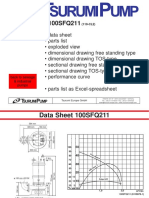COMPUTER SCIENCE 2023-24
VISWAPRAKASH CENTRAL SCHOOL
(Affiliated to CBSE, New Delhi. Affiliation No.930625)
Mangattukadavu, Thirumala P.O, Thiruvananthapuram-695006
CLASS XII PROJECT
COMPUTER SCIENCE
2023-2024
NAME: LEONDAVID
CLASS: XII - A
Register No. ...................
1
COMPUTER SCIENCE 2023-24
CERTIFICATE
This is to certify that the Project/Dissertation entitled by
LEON DAVID of class XII A is a bonafide work submitted Mrs. Soorya
Nair M. S. PGT (CS) for consideration partial fulfilment of the
requirement of the award SENIOR SECONDARY CERTIFICATE
EXAMINATION in COMPUTER SCIENCE
MRS. SOORYA NAIR M. S.
(Internal Examiner) MRS. SMITHA S.
PGT Computer Science PRINCIPAL
EXTERNAL EXAMINER
DECLARATION
2
COMPUTER SCIENCE 2023-24
I, LEON DAVID do hereby declare that this project
report on HOSPITAL Management System is a record
of study and work carried out by me and no part of this
has been submitted by me for the award of any
certificate or recognition before.
Thiruvananthapuram Signature:
Date LEON DAVID
Register No.
TABLE OF CONTENTS
3
COMPUTER SCIENCE 2023-24
Sl.No. DESCRIPTION Page No.
01 ACKNOWLEDGEMENT 05
02 INTRODUCTION 06
03 OBJECTIVES OF THE PROJECT 06
04 PROPOSED SYSTEM 07
05 SYSTEM DEVELOPMENT LIFE CYCLE (SDLC) 08
PHASES OF SYSTEM DEVELOPMENT LIFE
06 09
CYCLE
07 TESTING 17
08 HARDWARE AND SOFTWARE REQUIREMENTS 32
09 SOURCE CODE 21
10 OUTPUT 22
11 BIBLIOGRAPHY 43
ACKNOWLEDGEMENT
4
COMPUTER SCIENCE 2023-24
Apart from my efforts, the success of any project depends largely on the
encouragement and guidance of many others. I take this opportunity to express
my gratitude to all who have been instrumental in the successful completion of
this project.
I express my deep sense of gratitude to the almighty God for giving me
strength for the successful completion of the project.
I express my heartfelt gratitude to my parents for their constant
encouragement while carrying out this project.
I gratefully acknowledge the contribution of the individuals who
contributed in bringing this project up to this level.
I express my deep sense of gratitude to Mrs. Smitha S, The Principal,
Viswaprakash Central School, who has motivated and helped us throughout the
course.
I express my thanks to our Manager Rev.Fr Rex Morais for providing
the infrastructure and moral support to carry out this project in the school.
I express my sincere and heartfelt gratitude to Mrs. Soorya Nair M.S,
teacher in-charge, my guide, mentor and above all a friend, who critically
reviewed my project and helped in solving each and every problem that
occurred during the implementation of the project.
The guidance and support received from all the members who contributed
to this project was vital for the success of the project. I am grateful for their
constant support and help.
5
COMPUTER SCIENCE 2023-24
PROJECT ON HOSPITAL MANAGEMENT SYSTEM
INTRODUCTION
The Scope of the project takes care of the details of each and every department. These
details gives the doctor, staffs, specialists and patient details including their salary,
Attendance, doctor’s appointments and the billing system. The details of Doctor and staff
help the hospital to maintain the record of every person. Their attendance details help them to
know about their attentive presence while salary is calculated. The billing system provides an
efficient way for calculating bill details of the patients..
OBJECTIVES OF THE PROJECT
The objective of this project is to let the students apply the programming
knowledge into a real-world situation/problem and expose the students to how
programming skills helps in developing a good software.
1. Write programs utilizing modern software tools.
2. Apply object-oriented programming principles effectively when developing small to
medium sized projects.
3. Write effective procedural code to solve small to medium sized problems.
4. Students demonstrate a breadth of knowledge in computer science, as exemplified in
the areas of systems, theory and software development. Students demonstrate ability
6
COMPUTER SCIENCE 2023-24
to conduct research or applied Computer Science project, requiring writing and
presentation skills which exemplify scholarly style in computer science.
PROPOSED SYSTEM
The wise saying “To err is human” is no longer valid, it’s out-dated to
rationalize your mistake. One cannot afford to rely on fallible human beings if one
really wants to withstand today’s merciless competition. So, to keep pace with time,
to bring about the best result without malfunctioning and for greater efficiency we
can replace the heaps of files with a more sophisticated hard disk of the computer.
One has to use the data management software. Software has been an asset
in automation of various organisations. Many software products available now in
markets, have helped in making the organization’s work easier and efficient. Data
management initially had to maintain a lot of ledgers and a lot of paperwork. But
now, software has helped this organization make their work faster and easier. Now,
only this software has to be loaded on the computer and the work can be done.
This prevents a loss of time and money. Work becomes fully automated and
7
COMPUTER SCIENCE 2023-24
any information regarding the organization can be obtained by clicking the button.
Moreover, now it’s an age of computers and automating such an organization gives
it a better look.
SYSTEM DEVELOPMENT LIFE CYCLE (SDLC)
The systems development life cycle is a project management technique that
divides complex projects into smaller, more easily managed segments or phases.
Segmenting projects allows managers to verify the successful completion of project
phases before allocating resources to subsequent phases.
Software development projects typically include initiation, planning, design,
development, testing, implementation, and maintenance phases. However, the
phases may be divided differently depending on the organization involved.
8
COMPUTER SCIENCE 2023-24
For example, initial project activities might be designated as request,
requirements definition, and planning phases, or initiation, concept development, and
planning phases. End users of the system under development should be involved in
reviewing the output of each phase to ensure the system is being built to deliver the
needed functionality.
PHASES OF SYSTEM DEVELOPMENT LIFE CYCLE
INITIATION PHASE
The Initiation Phase begins when a business sponsor identifies a need or an
opportunity.
The purpose of the Initiation Phase is to:
Identify and validate an opportunity to improve business accomplishments of
the organization or a deficiency related to a business need.
Identify significant assumptions and constraints on solutions to that need.
Recommend the exploration of alternative concepts and methods to satisfy the
need including questioning the need for technology, i.e., will a change in the
business process offer a solution?
Assure executive business and executive technical sponsorship. The Sponsor
designates a Project Manager and the business need is documented in a
Concept Proposal. The Concept Proposal includes information about the
business process and the relationship to the Agency/Organization.
9
COMPUTER SCIENCE 2023-24
Infrastructure and the Strategic Plan. A successful Concept Proposal results
in a Project Management Charter which outlines the authority of the project
manager to begin the project.
Careful oversight is required to ensure projects support strategic business
objectives and resources are effectively implemented into an organization's
enterprise architecture. The initiation phase begins when an opportunity to
add, improve, or correct a system is identified and formally requested through
the presentation of a business case. The business case should, at a
minimum, describe a proposal’s purpose, identify expected benefits, and
explain how the proposed system supports one of the organization’s
business strategies.
SYSTEM CONCEPT DEVELOPMENT PHASE
The System Concept Development Phase begins after a business need or
opportunity is validated by the Agency/Organization Program Leadership and the
Agency/Organization CIO.
The purpose of the System Concept Development Phase is to:
Determine the feasibility and appropriateness of the alternatives.
Identify system interfaces.
Identify basic functional and data requirements to satisfy the business need.
Establish system boundaries; identify goals, objectives, critical success factors,
and performance measures.
Evaluate costs and benefits of alternative approaches to satisfy the basic
functional requirements
Assess project risks
10
COMPUTER SCIENCE 2023-24
Identify and initiate risk mitigation actions, and develop high-level technical
architecture, process models, data models, and a concept of operations. This
phase explores potential technical solutions within the context of the business
need.
It may include several trade-off decisions such as the decision to use COTS
software products as opposed to developing custom software or reusing
software components, or the decision to use an incremental delivery versus a
complete, onetime deployment.
Construction of executable prototypes is encouraged to evaluate technology
to support the business process. The System Boundary Document serves as
an important reference document to support the Information Technology
Project Request (ITPR) process.
The ITPR must be approved by the State CIO before the project can move
forward.
PICTORIAL REPRESENTATION OF SDLC:
11
COMPUTER SCIENCE 2023-24
PLANNING PHASE
The planning phase is the most critical step in completing development,
acquisition, and maintenance projects. Careful planning, particularly in the early
stages of a project, is necessary to coordinate activities and manage project risks
effectively. The depth and formality of project plans should be commensurate with
the characteristics and risks of a given project. Project plans refine the information
gathered during the initiation phase by further identifying the specific activities and
resources required to complete a project.
A critical part of a project manager’s job is to coordinate discussions between
user, audit, security, design, development, and network personnel to identify and
document as many functional, security, and network requirements as possible.
During this phase, a plan is developed that documents the approach to be used and
includes a discussion of methods, tools, tasks, resources, project schedules, and
‘user input. Personnel assignments, costs, project schedule, and target dates are
established.
A Project Management Plan is created with components related to acquisition
planning, configuration management planning, quality assurance planning, concept
of operations, system security, verification and validation, and systems engineering
management planning.
REQUIREMENTS ANALYSIS PHASE
This phase formally defines the detailed functional user requirements using high-
level requirements identified in the Initiation, System Concept, and Planning phases.
It also delineates the requirements in terms of data, system performance, security,
and maintainability requirements for the system. The requirements are defined in this
phase to a level of detail sufficient for systems design to proceed. They need to be
measurable, testable, and relate to the business need or opportunity identified in the
12
COMPUTER SCIENCE 2023-24
Initiation Phase. The requirements that will be used to determine acceptance of the
system are captured in the Test and Evaluation Master Plan.
The purposes of this phase are to:
Further define and refine the functional and data requirements and document
them in the Requirements Document,
Complete business process reengineering of the functions to be supported
(i.e., verify what information drives the business process, what information is
generated, who generates it, where does the information go, and who
processes it),
Develop detailed data and process models (system inputs, outputs, and the
process.
Develop the test and evaluation requirements that will be used to determine
acceptable system performance.
DESIGN PHASE
The design phase involves converting the informational, functional, and
network requirements identified during the initiation and planning phases into unified
design specifications that developers use to script programs during the development
phase. Program designs are constructed in various ways. Using a top-down
approach, designers first identify and link major program components and interfaces,
then expand design layouts as they identify and link smaller subsystems and
connections. Using a bottom-up approach, designers first identify and link minor
program components and interfaces, then expand design layouts as they identify
and link larger systems and connections. Contemporary design techniques often use
prototyping tools that build mock-up designs of items such as application screens,
database layouts, and system architectures. End users, designers, developers,
13
COMPUTER SCIENCE 2023-24
database managers, and network administrators should review and refine the
prototyped designs in an iterative process until they agree on an acceptable design.
Audit, security, and quality assurance personnel should be involved in the review
and approval process. During this phase, the system is designed to satisfy the
functional requirements identified in the previous phase. Since problems in the
design phase could be very expensive to solve in the later stage of the software
development, a variety of elements are considered in the design to mitigate risk.
These include:
Identifying potential risks and defining mitigating design features.
Performing a security risk assessment.
Developing a conversion plan to migrate current data to the new system.
Determining the operating environment.
Defining major subsystems and their inputs and outputs.
Allocating processes to resources.
Preparing detailed logic specifications for each software module. The result is
a draft System Design Document which captures the preliminary design for
the system.
Everything requiring user input or approval is documented and reviewed by the
user. Once these documents have been approved by the Agency CIO and
Business Sponsor, the final System Design Document is created to serve as
the Critical/Detailed Design for the system.
This document receives a rigorous review by Agency technical and functional
representatives to ensure that it satisfies the business requirements.
Concurrent with the development of the system design, the Agency Project
14
COMPUTER SCIENCE 2023-24
Manager begins development of the Implementation Plan, Operations and
Maintenance Manual, and the Training Plan.
DEVELOPMENT PHASE The development phase involves converting design
specifications into executable programs. Effective development standards include
requirements that programmers and other project participants discuss design
specifications before programming begins. The procedures help ensure
programmers clearly understand program designs and functional requirements.
Programmers use various techniques to develop computer programs. The large
transaction oriented programs associated with financial institutions have traditionally
been developed using procedural programming techniques. Procedural
programming involves the line-by-line scripting of logical instructions that are
combined to form a program. Effective completion of the previous stages is a key
factor in the success of the Development phase. The Development phase consists of
Translating the detailed requirements and design into system components.
Testing individual elements (units) for usability.
Preparing for integration and testing of the IT system.
INTEGRATION AND TEST PHASE
Subsystem integration, system, security, and user acceptance testing is
conducted during the integration and test phase. The user, with those responsible for
quality assurance, validates that the functional requirements, as defined in the
functional requirements document, are satisfied by the developed or modified
system. OIT Security staff assesses the system security and issue a security
certification and accreditation prior to installation/implementation.
15
COMPUTER SCIENCE 2023-24
Multiple levels of testing are performed, including:
Testing at the development facility by the contractor and possibly supported by
end users
Testing as a deployed system with end users working together with contract
personnel
Operational testing by the end user alone performing all functions.
Requirements are traced throughout testing, a final Independent Verification &
Validation evaluation is performed and all documentation is reviewed and
accepted prior to acceptance of the system.
IMPLEMENTATION PHASE
This phase is initiated after the system has been tested and accepted by the user. In
this phase, the system is installed to support the intended business functions.
System performance is compared to performance objectives established during the
planning phase. Implementation includes user notification, user training, installation
of hardware, installation of software onto production computers, and integration of
the system into daily work processes. This phase continues until the system is
operating in production in accordance with the defined user requirements.
OPERATIONS AND MAINTENANCE PHASE
The system operation is on-going. The system is monitored for continued
performance in accordance with user requirements and needed system
modifications are incorporated. Operations continue as long as the system can be
effectively adapted to respond to the organization’s needs. When modifications or
changes are identified, the system may re-enter the planning phase.
The purpose of this phase is to:
16
COMPUTER SCIENCE 2023-24
Operate, maintain, and enhance the system.
Certify that the system can process sensitive information.
Conduct periodic assessments of the system to ensure the functional
requirements continue to be satisfied.
Determine when the system needs to be modernized, replaced, or retired.
TESTING
Software Testing is an empirical investigation conducted to provide
stakeholders with information about the quality of the product or service under
test[1] , with respect to the context in which it is intended to operate. Software
Testing also provides an objective, independent view of the software to allow the
business to appreciate and understand the risks at implementation of the software.
Test techniques include, but are not limited to, the process of executing a program
or application with the intent of finding software bugs.
It can also be stated as the process of validating and verifying that a
software program/application/product meets the business and technical
17
COMPUTER SCIENCE 2023-24
requirements that guided its design and development, so that it works as expected
and can be implemented with the same characteristics. Software Testing,
depending on the testing method employed, can be implemented at any time in the
development process, however the most test effort is employed after the
requirements have been defined and coding process has been completed.
TESTING METHODS
Software testing methods are traditionally divided into black box testing and
white box testing. These two approaches are used to describe the point of view that
a test engineer takes when designing test cases.
BLACK BOX TESTING
Black box testing treats the software as a "black box," without any knowledge
of internal implementation. Black box testing methods include: equivalence
partitioning, boundary value analysis, all-pairs testing, fuzz testing, model-based
testing, traceability matrix, exploratory testing and specification-based testing.
SPECIFICATION-BASED TESTING
Specification-based testing aims to test the functionality of software
according to the applicable requirements.[16] Thus, the tester inputs data into, and
only sees the output from, the test object. This level of testing usually requires
18
COMPUTER SCIENCE 2023-24
thorough test cases to be provided to the tester, who then can simply verify that for
a given input, the output value (or behaviour), either "is" or "is not" the same as the
expected value specified in the test case. Specification-based testing is necessary,
but it is insufficient to guard against certain risks
ADVANTAGES AND DISADVANTAGES
The black box tester has no "bonds" with the code, and a tester's perception
is very simple: a code must have bugs. Using the principle, "Ask and you shall
receive," black box testers find bugs where programmers don't. But, on the other
hand, black box testing has been said to be "like a walk in a dark labyrinth without a
flashlight," because the tester doesn't know how the software being tested was
actually constructed.
That's why there are situations when (1) a black box tester writes many test
cases to check something that can be tested by only one test case, and/or (2) some
parts of the back end are not tested at all. Therefore, black box testing has the
advantage of "an unaffiliated opinion," on the one hand, and the disadvantage of
"blind exploring," on the other.
WHITE BOX TESTING
White box testing, by contrast to black box testing, is when the tester has
access to the internal data structures and algorithms (and the code that implement
these)
19
COMPUTER SCIENCE 2023-24
Types of white box testing:-
The following types of white box testing exist:
api testing - Testing of the application using Public and Private APIs.
Code coverage - creating tests to satisfy some criteria of code
coverage.
For example, the test designer can create tests to cause all statements in the
program to be executed at least once. fault injection methods. mutation testing
methods. static testing - White box testing includes all static testing.
CODE COMPLETENESS EVALUATION
White box testing methods can also be used to evaluate the completeness of
a test suite that was created with black box testing methods. This allows the
software team to examine parts of a system that are rarely tested and ensures that
the most important function points have been tested.
Two common forms of code coverage are:
Function Coverage: Which reports on functions executed and
Statement Coverage: Which reports on the number of lines executed to
complete the test.
20
COMPUTER SCIENCE 2023-24
They both return coverage metric, measured as a percentage
HARDWARE AND SOFTWARE REQUIREMENTS
I. OPERATING SYSTEM : WINDOWS AND ABOVE
II. PROCESSOR : PENTIUM(ANY) OR AMD
ATHALON(3800+- 4200+ DUALCORE)
III. MOTHERBOARD : 1.845 OR 915,995 FOR PENTIUM 0R MSI
21
COMPUTER SCIENCE 2023-24
K9MM-V VIAK8M800+8237R PLUS
CHIPSET FOR AMD ATHALON
IV. RAM : 512MB+
V. Hard disk : SATA 40 GB OR ABOVE
VI. CD/DVD r/w multi drive combo: (If back up required)
VII. FLOPPY DRIVE 1.44 MB : (If Backup required)
VIII. MONITOR 14.1 or 15 -17 inch
IX. Key board and mouse
X. Printer : (if print is required – [Hard copy])
SOFTWARE REQUIREMENTS:
1. Windows OS
2. Python
3. MySQL
22
COMPUTER SCIENCE 2023-24
SOURCE CODE
while(True):
print("""
================================
WELCOME TO MYHOSPITAL
23
COMPUTER SCIENCE 2023-24
================================
""")
import mysql.connector
passwd=str(input("ENTER THE DATABASE PASSWORD;"))
mysql=mysql.connector.connect(host="localhost",user="root",password="Leon@123")
mycursor=mysql.cursor()
mycursor.execute("create database if not exists my_hospitals")
mycursor.execute("use my_hospitals")
mycursor.execute("create table if not exists patient_details(puid int(10) primary key,name
varchar(30) not null,sex char(2),age int(3),address varchar(50),contact int)")
mycursor.execute("create table if not exists doctor_details(name varchar(30) primary
key,specialisation varchar(40),age int(2),address varchar(30),contact varchar(15),fees
int(10),monthly_salary int(10))")
mycursor.execute("create table if not exists nurse_details(name varchar(30) primary key,age
int(2),address varchar(30),contact varchar(15),monthly_salary int(10))")
mycursor.execute("create table if not exists other_workers_details(name varchar(30) primary
key,age int(2),address varchar(30),contact varchar(15),monthly_salary int(10))")
mycursor.execute("create table if not exists user_data(username varchar(30) primary key,password
varchar(30) default'000')")
24
COMPUTER SCIENCE 2023-24
while(True):
print("""
1. SIGN IN (LOGIN)
2. SIGN UP (REGISTER)
""")
r=int(input("enter your choice:"))
if r==2:
print("""
=======================================
!!!!!!!PLEASE REGISTER YOURSELF!!!!!!!!
=======================================
""")
u=input("ENTER YOUR PREFERRED USERNAME!!:")
p=input("ENTER YOUR PREFERRED PASSWORD (PASSWORD SHOULD BE STRONG!!!:")
mycursor.execute("insert into user_data values('"+u+"','"+p+"')")
mysql.commit()
25
COMPUTER SCIENCE 2023-24
print("""
=======================================
!!!!!!!!REGISTERED SUCCESSFULLY!!!!!!!!
=======================================
""")
x=input("enter any key to continue:")
elif r==1:
print("""
==================================
!!!!!!!! {{SIGN IN }} !!!!!!!!!!
==================================
""")
un=input("ENTER THE USERNAME!!:")
ps=input("ENTER THE PASSWORD!!:")
26
COMPUTER SCIENCE 2023-24
mycursor.execute("select password from user_data where username='"+un+"'")
row=mycursor.fetchall()
for i in row:
a=list(i)
if a[0]==str(ps):
while(True):
print("""
1.ADMINISTRATION
2.PATIENT (ADMISSION NAD DISCHARGE PROCESS)
3.SIGN OUT
""")
a=int(input("ENTER YOUR CHOICE:"))
if a==1:
print("""
27
COMPUTER SCIENCE 2023-24
1. SHOW DETAILS
2. ADD NEW MEMBER
3. DELETE EXISTING ONE
4. EXIT
""")
b=int(input("ENTER YOUR CHOICE:"))
if b==1:
print("""
1. DOCTOR DETAILS
2. NURSE DETAILS
3. OTHER WORKERS
""")
c=int(input("ENTER YOUR CHOICE:"))
if c==1:
mycursor.execute("select * from doctor_details")
row=mycursor.fetchall()
for i in row:
28
COMPUTER SCIENCE 2023-24
b=0
v=list(i)
k=["NAME","SPECIALISATION","AGE","ADDRESS","CONTACT","FEES","MONTHLY_SALARY"]
d=dict(zip(k,v))
print(d)
elif c==2:
mycursor.execute("select * from nurse_details")
row=mycursor.fetchall()
for i in row:
v=list(i)
k=["NAME","SPECIALISATION","AGE","ADDRESS","CONTACT","MONTHLY_SALARY"]
d=dict(zip(k,v))
print(d)
elif c==3:
mycursor.execute("select * from other_workers_details")
row=mycursor.fetchall()
for i in row:
29
COMPUTER SCIENCE 2023-24
v=list(i)
k=["NAME","SPECIALISATION","AGE","ADDRESS","CONTACT","MONTHLY_SALARY"]
d=dict(zip(k,v))
print(d)
elif b==2:
print("""
1. DOCTOR DETAILS
2. NURSE DETAILS
3. OTHER WORKERS
""")
c=int(input("ENTER YOUR CHOICE:"))
if c==1:
name=input("ENTER DR. NAME:")
spe=input("ENTER SPECIALISATION:")
age=input("ENTER AGE:")
30
COMPUTER SCIENCE 2023-24
add=input("ENTER ADDRESS:")
cont=input("ENTER CONTACT NO.:")
fees=input("ENTER FEES:")
ms=input("ENTER MONTHLY_SALARY:")
mycursor.execute("insert into doctor_details
values('"+name+"','"+spe+"','"+age+"','"+add+"','"+cont+"','"+fees+"','"+ms+"')")
mysql.commit()
print("SUCCESSFULLY ADDED")
elif c==2:
name=input("ENTER NURSE NAME:")
age=input("ENTER AGE:")
add=input("ENTER ADDRESS:")
cont=input("ENTER CONTACT NO.:")
ms=int(input("ENTER MONTHLY_SALARY:"))
mycursor.execute("insert into nurse_details
values('"+name+"','"+age+"','"+add+"','"+cont+"','"+str(ms)+"')")
mysql.commit()
print("SUCCESSFULLY ADDED")
31
COMPUTER SCIENCE 2023-24
elif c==3:
name=input("ENTER WORKER NAME:")
age=input("ENTER AGE:")
add=input("ENTER ADDRESS:")
cont=input("ENTER CONTACT NO.:")
ms=input("ENTER MONTHLY_SALARY:")
mycursor.execute("insert into other_workers_details
values('"+name+"','"+age+"','"+add+"','"+cont+"','"+ms+"')")
mysql.commit()
print("SUCCESSFULLY ADDED")
elif b==3:
print("""
1. DOCTOR DETAILS
2. NURSE DETAILS
3. OTHER WORKERS
""")
32
COMPUTER SCIENCE 2023-24
c=int(input("ENTER YOUR CHOICE:"))
if c==1:
name=input("ENTER DOCTOR'S NAME:")
mycursor.execute("select * from doctor_details where name=='"+name+"'")
row=mycursor.fetchall()
print(row)
p=input("you really wanna delete this data? (y/n):")
if p=="y":
mycursor.execute("delete from doctor_details where name='"+name+"'")
mysql.commit()
print("SUCCESSFULLY DELETED!!")
else:
print("NOT DELETED")
elif c==2:
name=input("ENTER NURSE NAME:")
mycursor.execute("select * nurse_details where name=='"+name+"'")
row=mycursor.fetchall()
print(row)
p=input("you really wanna delete this data? (y/n):")
33
COMPUTER SCIENCE 2023-24
if p=="y":
mycursor.execute("delete from nurse_details where name='"+name+"'")
mysql.commit()
print("SUCCESSFULLY DELETED!!")
else:
print("NOT DELETED")
elif c==3:
name=input("ENTER THE WORKER NAME:")
mycursor.execute("select * from workers_details where name=='"+name+"'")
row=mycursor.fetchall()
print(row)
p=input("you really wanna delete this data? (y/n):")
if p=="y":
mycursor.execute("delete from other_workers_details where
name='"+name+"'")
mysql.commit()
print("SUCCESSFULLY DELETED!!")
else:
print("NOT DELETED")
34
COMPUTER SCIENCE 2023-24
elif b==4:
break
elif a==2:
print("""
1. SHOW PATIENT DETAILS
2. ADD NEW PATIENT
3. DISCHARGE PATIENT
4. EXIT
""")
b=int(input("ENTER YOUR CHOICE:"))
if b==1:
mycursor.execute("select * from patient_details")
row=mycursor.fetchall()
for i in row:
b=0
v=list(i)
k=["NAME","SEX","AGE","ADDRESS","CONTACT"]
d=dict(zip(k,v))
print(d)
35
COMPUTER SCIENCE 2023-24
elif b==2:
puid=str(input("ENTER patientid : "))
name=str(input("ENTER NAME: "))
sex=str(input("ENTER SEX: "))
age=str(input("ENTER AGE: "))
address=str(input("ADDRESS: "))
contact=str(input("CONTACT NUMBER: "))
mycursor.execute ("insert into patient_details values('"+str(puid)+"','"+str(name)
+"','"+str(sex)+"','"+str(age)+"','"+str(address)+"','"+str(contact)+"')")
mysql.commit()
mycursor.execute("select * from patient_details")
for i in mycursor:
v=list(i)
k=['puid','NAME','AGE','ADDRESS','CONTACT']
print(dict(zip(k,v)))
print("""
====================================
!!!!!!!REGISTERED SUCCESSFULLY!!!!!!
36
COMPUTER SCIENCE 2023-24
====================================
""")
elif b==3:
name=input("ENTER THE PATIENT NAME:")
mycursor.execute("select * from patient_details where name='"+name+"'")
row=mycursor.fetchall()
print(row)
bill=input("HAS HE PAID ALL THE BILLS ? (y/n):")
if bill=="y":
mycursor.execute("delete from patient_details where name='"+name+"'")
mysql.commit()
elif b==4:
break
elif a==3:
break
else:
break
mysql.close()
37
COMPUTER SCIENCE 2023-24
OUTPUT
38
COMPUTER SCIENCE 2023-24
39
COMPUTER SCIENCE 2023-24
40
COMPUTER SCIENCE 2023-24
41
COMPUTER SCIENCE 2023-24
42
COMPUTER SCIENCE 2023-24
43
COMPUTER SCIENCE 2023-24
BIBLOGRAPHY
1. Computer science With Python - Class XI/XII By : Sumita
Arora
2. A Project Report On Blood Bank Management System (BBMS) By :
Praveen M Jigajinni
3. Website: https://python4csip.com/
***
44
COMPUTER SCIENCE 2023-24
45










